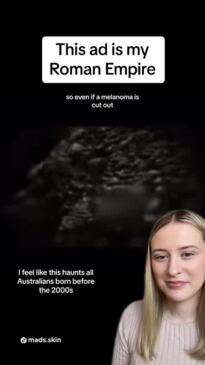Tracking ancestry key to skin cancer ‘blind spot’
Tracking ancestry against melanoma rates could be key to eliminating the most prevalent cancer in Australia.

You can now listen to The Australian's articles. Give us your feedback.
The first study gauging the effect of Australia’s diversifying population on melanoma rates has found a major drop in people at high sun damage risk, allowing researchers to better target awareness campaigns.
The QIMR Berghofer Medical Research Institute found the portion of the population at high risk of melanoma had declined from 85 per cent in 2006 to 71 per cent in 2021.
The change to Australia’s population composition was most pronounced in young people, where almost 30 per cent of those marked on the census had darker skin tones carrying a low to moderate risk of melanoma.
The rate at which the population has diversified, decades of awareness campaigns and shifting social trends are all moving the dial towards a declining rate of Australia’s national cancer.
While other countries with high melanoma rates and equivalent migration patterns saw a reduction in skin cancers, Australia was still remarkable based on the success of its public awareness campaigns.

“Australia is not the same place now that it was 40 years ago, and certainly not 80 years ago. We have a much more diverse population,” QIMR Berghofer melanoma researcher David Whiteman said.
“We have a lot of people here who have skin types that put them at low risk of melanoma … and that hadn’t been factored in when we looked at the total rates in the total population until now.”
Professor Whiteman said the results would likely be most pronounced in urban centres, while the regions would be best targeted with continual skin cancer awareness campaigning given their lower rates of diversity.
“We need to be making sure we have campaigns … hitting the mark and changing behaviour,” he said. “Here in Brisbane it’s been 30 degrees on the last day of winter, and there will be people outside basking in the sun and exposing themselves.
“That means we’re going to likely have a longer spring-summer-autumn period when people are outdoors. So it could theoretically lead to higher levels of sun exposure, which could translate into a higher risk of skin cancer.”

The study, based on analysis of census data alongside melanoma rates by age group and ancestry, was funded by the National Health and Medical Research Council and published in full in the Medical Journal of Australia.
Professor Whiteman hoped this epidemiological approach could be applied in more public health research and cancer tracking. “Ancestry can be a very important determinant of some diseases … It’s probably the case for many other diseases,” he said.
“Yet our disease registries don’t really capture ancestry at all, it’s a bit of a blind spot.
“Historically people have felt sensitive about disclosing those sorts of things, and that’s understandable. So it has to be done sensitively and in consultation, but it can be very helpful and powerful for directing services to where they’re needed most.”
Two-thirds of Australians will be diagnosed with skin cancer in their lifetime. It represents one of the most extreme medical burdens on our health system, with over one million treatments administered annually.
Professor Whiteman’s study also found a drop in melanoma rates among young, fair-skinned Australians with European ancestry, supporting evidence that decades of government-backed messaging had reached the public consciousness.






To join the conversation, please log in. Don't have an account? Register
Join the conversation, you are commenting as Logout